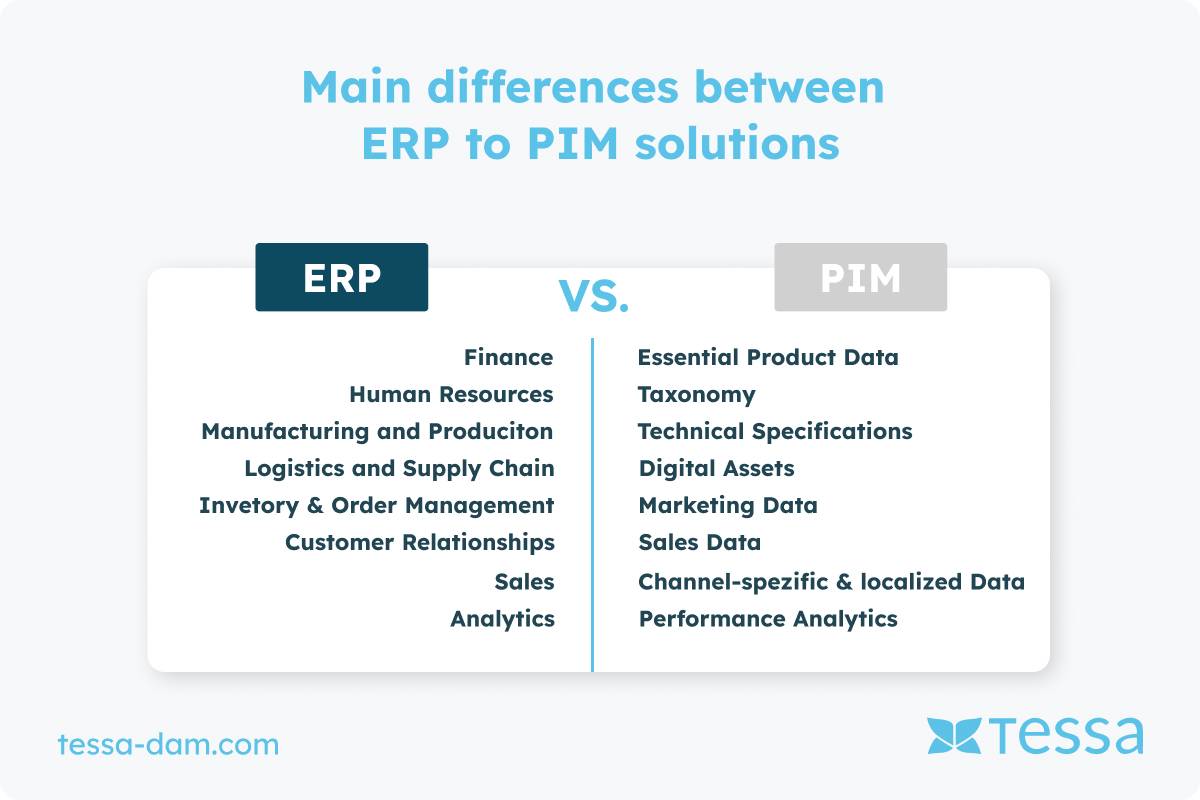What is PIM - Product Information Management?
Your PIM – Product Information Management System – is a tool for product data management. It is used for storing and managing product-related attributes (e.g., colors, weights, etc.), texts (product descriptions in various lengths and languages), as well as categories and assortments. A PIM system thus serves as the single point of truth for product master data within the company. Product information enters the PIM via upstream systems, where it is consolidated and enriched. One such enrichment is the translation of content. These enriched contents are then used—often combined with digital assets from DAM systems—for print and electronic catalogs, websites and e-commerce applications, as well as for data distribution to retail or platforms. The technical foundation is typically an SQL system.
Why do companies need PIM - Product Information Management?
When organizations manage information for a large number of products, it becomes a real challenge. This applies to both manufacturing companies and retailers. The task is always to establish a consistent information structure for all their products. For retailers, using a PIM allows them to achieve homogeneous data quality across all suppliers and product categories. Manufacturers typically consolidate data from various sources within a PIM, control data quality, and thus obtain an optimal foundation for omnichannel commerce. At the same time, the PIM serves as the basis for translation processes into various languages. Thus, PIM systems serve as a starting point for the internationalization of companies with many products. Moreover, it is possible to tailor the attribute data, texts, and categories contained in the PIM to specific customers and partners within predefined assortments. Therefore, PIM systems are an essential prerequisite for the growing platform business, making them a relevant competitive factor. They ensure competitiveness and enable revenue growth.
What does the Product Information Management process look like?
The PIM process, also known as the Product Lifecycle, consists of various steps aimed at creating, managing, and distributing high-quality and consistent product information. Here is a typical representation of the PIM process:
-
Data Import: Product information is imported from various sources, including suppliers, manufacturers, and internal systems. This step ensures the central collection of all relevant data.
-
Data Cleansing and Harmonization: Imported data is checked for quality, cleaned, and standardized into a uniform format. This includes the unification of attributes, categories, and other relevant information.
-
Product Information Enrichment: Additional information such as product descriptions, images, technical specifications, and marketing texts is added to complete and enhance the product information.
-
Classification and Taxonomy: Products are organized into categories and classifications to ensure a consistent and logical structure. This facilitates easier search and access to information.
-
Translations: If necessary, product information is translated into different languages to support international marketing.
-
Quality Control: A comprehensive quality check is performed to ensure that all product information is accurate, consistent, and up-to-date.
-
Data Release: Approval and release processes are implemented to ensure that only verified and authorized information is published.
-
Publication: Product information is exported to various sales channels, including e-commerce websites, catalogs, mobile applications, and more.
-
Monitoring and Updating: The process is continuously monitored, and updates are made as needed to ensure that product information remains accurate and relevant.
This PIM process helps increase efficiency in managing product information and ensures consistent representation across various sales channels. The exact structure may vary depending on specific requirements and the type of products involved.
Who benefits from a PIM system?
What are the areas of application for PIM?
Product Information Management (PIM) is used in various areas of a company to ensure the efficient management of product information. Here are some of the main areas where PIM is used:
Which market players benefit from a PIM system?
The implementation of a Product Information Management (PIM) system brings benefits to various market players. Manufacturers and suppliers can centralize and standardize their product information, which improves collaboration with sales partners and enables consistent product presentations on different platforms. Retailers benefit by optimizing their product catalogs, improving the quality of product information and increasing efficiency when publishing on different sales channels.
Brand owners ensure consistent brand communication and improve the visibility of their products. Marketing teams can access high-quality and updated product information to create consistent marketing materials. Purchasing departments keep track of supplier information, contracts and product catalogs. Sales and distribution teams benefit from accurate product information for effective customer support. IT departments are responsible for implementing and maintaining PIM systems to ensure data flow and integration.
Ultimately, end customers also experience an improved purchasing experience through accurate, comprehensive and engaging product information.
Which systems does a PIM work with?
In principle, it's possible to enter product data directly into PIM systems. However, in most cases, data entry takes place in upstream systems. Retailers often request data from their suppliers in formats like CSV or Excel, specifying a fixed attribute set for data delivery. This allows for quickly presenting many products in their online shops. Moreover, there are often interfaces for importing product data from standard formats. Examples of such standard formats include ETIM, commonly used in the electrical industry, or cross-industry standards like eCl@ss and proficl@ss for parametric procedures.
Manufacturers increasingly use PLM systems - Product Life-Cycle Management. This is a management technology that collects all economically relevant information from the product concept stage onward. Products are usually sketched, market potential is assessed, offers are obtained from suppliers, and, of course, product data is recorded. In later stages of the product life cycle, sales figures are integrated, along with results from competitive monitoring.
In most cases, the product data from PLM is insufficient. It's necessary to combine it with morphological data from enterprise software (ERP). Gross weights and dimensions, as well as various packaging units and sizes, are examples of this.
Don't forget DAM systems like TESSA DAM, through which assets - such as images, drawings, documents, and any other files - can be correlated with products. Precursors to DAM tools were the so-called MAMs, Media Asset Management Systems, mainly used for managing images and videos.
When extracting the data, a PIM works with interface software like Lobster or Synesty, forwarding data to e-commerce systems or systems for automatic catalog publishing.
Which PIM solutions are available?
The market for PIM solutions is relatively complex. Over 90 solutions are listed on www.pim-verzeichnis.de. Broadly speaking, these can be divided into On-Premise and Cloud solutions. The key factor is whether the software runs on internal servers or in the cloud. The most widely adopted professional solution now involves positioning a dedicated server in the cloud. Below is a compiled list from OMR Reviews, where real users have chosen the top seven PIM systems (Current as of February 29, 2024):
Akeneo is, in our assessment, the most widely used professional system. There is both an open-source community version and a professional version supported by service providers. Akeneo works with the TESSA DAM via a dedicated interface.
PIMCORE falls into a similar category. It offers an open-source version, along with additional services. Informatica and SAP provide enterprise-level solutions.
Is SAP a PIM system?
SAP is not a traditional PIM system; rather, it is a comprehensive ERP (Enterprise Resource Planning) solution that covers a wide range of business processes—from finance and logistics to human resources. While SAP offers basic product data management, it is not specifically designed for the centralized management and distribution of detailed product information across various sales channels, as a PIM system is.
ERP systems like SAP focus on coordinating and streamlining operational processes by integrating functions such as order processing, inventory management, and financial accounting. In contrast, a PIM system is designed to centrally manage and distribute detailed, marketing-relevant product information. It provides specialized features like enrichment, translation, and classification of product data—essential for use in e-commerce, catalogs, and other sales channels.
Some companies expand their SAP systems with additional modules or interfaces to meet product data-specific requirements, but this often requires significant customization and resources. For most businesses, using a specialized PIM system is more efficient, as it is specifically tailored to the needs of product information management and can integrate seamlessly with ERP systems like SAP.
How much does a PIM system cost?
The costs of a PIM system can vary significantly. On one hand, there are free open-source solutions, and on the other hand, there are tools from enterprise providers such as SAP or Informatica.
As is common with many software products, there are:
- Setup costs,
- Annual costs for server operation,
- Costs depending on the number of accounts, i.e., the number of people using the system,
- Costs depending on the number of products (SKUs).
Additionally, some modules or interfaces might be billed separately.
Apart from these, there are costs associated with customization and updates that should not be overlooked. And, of course, personnel within the company will be needed to manage product data and operate the system.
Conclusion
Managing product data efficiently and consistently
A PIM system is essential for companies that want to efficiently and consistently manage and utilize their product data across all sales channels. By centralizing and enriching product information, a PIM not only improves data quality but also enables more flexible and faster content delivery for both domestic and international markets. In this way, Product Information Management plays a crucial role in enhancing competitiveness and customer satisfaction, providing companies with the foundation for successful multichannel marketing and international expansion.






